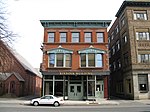Westfield, Massachusetts
1660 establishments in the Massachusetts Bay ColonyCities in Hampden County, MassachusettsCities in MassachusettsPopulated places established in 1660Russian-American culture in Massachusetts ... and 5 more
Russian communities in the United StatesSpringfield metropolitan area, MassachusettsUkrainian communities in the United StatesUse mdy dates from August 2016Westfield, Massachusetts

Westfield is a city in Hampden County, in the Pioneer Valley of western Massachusetts, United States. Westfield was first settled by Europeans in 1660. It is part of the Springfield, Massachusetts Metropolitan Statistical Area. The population was 40,834 at the 2020 census.
Excerpt from the Wikipedia article Westfield, Massachusetts (License: CC BY-SA 3.0, Authors, Images).Westfield, Massachusetts
Franklin Street, Westfield
Geographical coordinates (GPS) Address Nearby Places Show on map
Geographical coordinates (GPS)
| Latitude | Longitude |
|---|---|
| N 42.125 ° | E -72.75 ° |
Address
Franklin Street 41
01085 Westfield
Massachusetts, United States
Open on Google Maps











